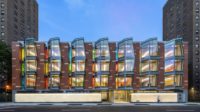In September 2022, Hurricane Ian tore across Florida and its Gulf Coast before its final landing in South Carolina, resulting in the second-deadliest storm to strike the U.S. this century, just behind 2005’s Hurricane Katrina. As a Category 4 storm, Ian’s top maximum sustained winds were 155 miles per hour (mph), resulting in current damage estimates between 53 billion and 74 billion dollars.1
With extreme storms like this becoming increasingly routine each year, it’s growing more important for building professionals in storm-prone areas to adapt their projects to consider when, rather than if, severe weather strikes. It may seem like planning for hurricanes limits what is possible from a design standpoint, especially when it comes to glazed curtain walls and windows. However, with occupants spending upwards of 90 percent of their time indoors, according to the United States Environmental Protection Agency, the need for balanced daylight and transparency has never been more valuable.
While many traditional glazing materials are susceptible to breakage upon high impact, precluding them from use in areas subject to severe weather, advances in channel glass systems are providing a solution. These systems make beautiful, weather-resilient glazed walls possible. Taking it a step further, hurricane-rated channel glass not only helps keep occupants physically safe but can also improve occupant wellness and experience by increasing access to daylight, contributing to stable internal temperatures and providing exceptional acoustic performance.
All Eyes on Channel Glass
To understand the design and performance of hurricane-rated channel glass, it is important to first understand standard channel glass systems. These linear systems consist of U-shaped cast-glass channels that are held in place by an extruded metal perimeter frame. They enable long, uninterrupted spans of glazing with striking lines and varying colors, translucencies and textures that allow soft light to filter through while still maintaining an element of privacy.
As a high-performance glazing system, channel glass assemblies have a distinctive appearance that promotes light transfer and also greatly impacts the overall visual aesthetic of a design. Although standard channel glass has an inherent, slightly green hue and a lightly dimpled surface texture, both attributes can be altered to fit a project’s aesthetics and daylighting goals. Textures can range from a high degree of clarity to enhanced patterns that increase privacy (think fluted waves, thin lines, or a netted surface). Thanks to high-performance coatings that are bonded to the glass, the color options for channel glass include a wide array of opacities and even metallic colors.
Additionally, channel glass can be designed in both single- and double-glazed configurations for either interior or exterior applications. It might be used for a feature wall, decorative cladding, rainscreens or as a greater part of the building envelope in place of a curtain wall or storefront. For coastal regions prone to storms, channel glass systems can also be specified as a hurricane-rated system, specifically designed to protect occupants from penetrating windborne debris and water infiltration.
Receiving a Hurricane Rating
Hurricane-rated channel glass passes rigorous tests to meet Miami-Dade County and state of Florida requirements, the current global hurricane-code benchmarks. The most common hurricane tests are the TAS 201, TAS 202, and TAS 203 impact and cycling tests, which simulate high-impact debris flying into the glass systems at determined locations. In the cycling portion, the glass is tested against intense and rapid increases and decreases in pressure that occur in a building during a hurricane.
Channel glass systems that pass these testing standards are referred to as large-missile impact-resistant channel glass systems and are more resilient to severe weather damage—both caused by windborne debris and breaches in the building envelope. As such, they do not need supplemental films or shutters, allowing design professionals to preserve the sleek, contemporary lines desirable in modern building design.
Able to provide the highest level of hurricane protection available in North America, large-missile impact-resistant channel glass systems are approved for heights up to 10 feet and can be installed in vertical configurations only, with no wind anchors necessary. Additionally, the systems allow for great design freedom as they can be stacked over floor slabs to create extended expanses of glazing, or they can be raked so that the panels change elevation gradually across their width. In areas prone to hurricanes or storm-blown debris, hurricane-rated channel glass systems can help provide physical protection for a building and its occupants without sacrificing a beautiful design.
Designing Beyond Building Codes
As important as visual aesthetic and physical safety are, design elements that promote mental and emotional wellbeing are often just as important. The building envelope influences both the first impression of a structure and how its interiors support the occupant experience. Therefore, a pleasing and purposeful design is key.
The advanced hurricane-rated glazing systems incorporate channel glass with a polycarbonate laminate bonded to its surface to meet Miami-Dade County and state of Florida requirements. The system, however, can still be specified in a variety of textures, patterns and colors, all of which contribute to daylighting goals. The visible light transmittance (VLT) for an uncoated, double-glazed channel glass system ranges between 70 and 75 percent, meaning occupants can enjoy a great dose of natural light.1 In exterior applications where channel glass systems function as part of the building envelope, the channels are dual glazed. To provide extra strength against heavy winds, these dual glazed channels can also be laid out in an overlapping fashion. No matter how bold the design is though, soft, even light from the natural world is able to filter through to the building’s interior.
While daylight has a powerful and positive effect on mental health and wellbeing, many now recognize the quality of light is as important as the quantity. The cast-glass channels inherently diffuse daylight for soft, balanced light transfer. With varying levels of translucency, design teams can go further, specifying channel glass systems to evenly distribute light while preventing glare or the need for blinds or shades. In this way, the systems reduce sharp lines, distracting shadows and bright sunlight for the type of daylighting that optimizes occupant comfort.
Like standard channel glass systems, hurricane-rated channel systems can also help manage heat transfer when they are dual glazed, making them ideal for light-transmitting walls where heat gain or loss is a concern. In this orientation, the overlapping channels create an insulated dead-air filled space and thermal gap. While the overlapping arrangement typically has a U-value of 0.49, channel glass configured with insulating materials has a U-value of 0.19, while still maintaining light transmission. Overall, insulated channel glass systems can help reduce heat loss and minimize solar heat gain.2 In both instances, channel glass improves a building’s energy consumption by stabilizing interior temperatures.
Just as heat and light affect building occupants, acoustical design can be an essential part of a build and an invaluable piece of the wellness puzzle. The sounds of a building can greatly affect occupants’ comfort, performance and wellbeing.3 When insulating materials are added, channel glass is able to reduce unwanted noise, resulting in a sound transmission class (STC) of 44. This mitigates the transfer of unwelcome sounds to improve occupant experience.
To visualize a real-world example of this, a high-end department store located in an upscale shopping center in Florida, uses a channel glass system on all three floors of its exterior façade. To satisfy local hurricane and wind codes, the design team specified a channel glass system that was hurricane-rated. The glass is lit from within providing a welcoming entrance, architectural appeal and emits a bright glow while bringing diffuse daylight into the space. Featuring excellent light transmission, energy efficiency and sound reduction the system also requires minimal maintenance. These qualities boost the wellbeing of employees and shoppers alike.
Creating a Shelter for Safety and Wellbeing
When it comes to designing a space with hurricane-rated channel glass, architects and building professionals don’t have to decide between safety and wellbeing. They go hand-in-hand.
With hurricane-rated channel glass, it is possible to blend safety, exquisite design and wellness. Channel glass systems can increase access to daylight, help stabilize interior temperatures and offer premium acoustic performance in addition to enhancing the visual appeal of a façade. They join an elite group of materials that can stand up to extreme weather, pass stringent life safety standards and contribute to the wellbeing of the end-user—pushing the envelope of what’s possible in building design.
[1.] Razwick, Jeff. (2013). “More than a pretty façade: Specifying with channel glass.” Retrieved from https://www.constructionspecifier.com/more-than-a-pretty-facade-specifying-with-channel-glass/
[2.] Razwick, Jeff. (2015). “Specifying high-performance assemblies.” Retrieved from https://www.constructionspecifier.com/channel-high-design-part-three/
[3.] Sandhana, Lakshmi. (2019). “How the sound in your home affects your mood.” Retrieved from https://www.bbc.com/future/article/20190729-how-the-sound-in-your-office-affects-your-mood





